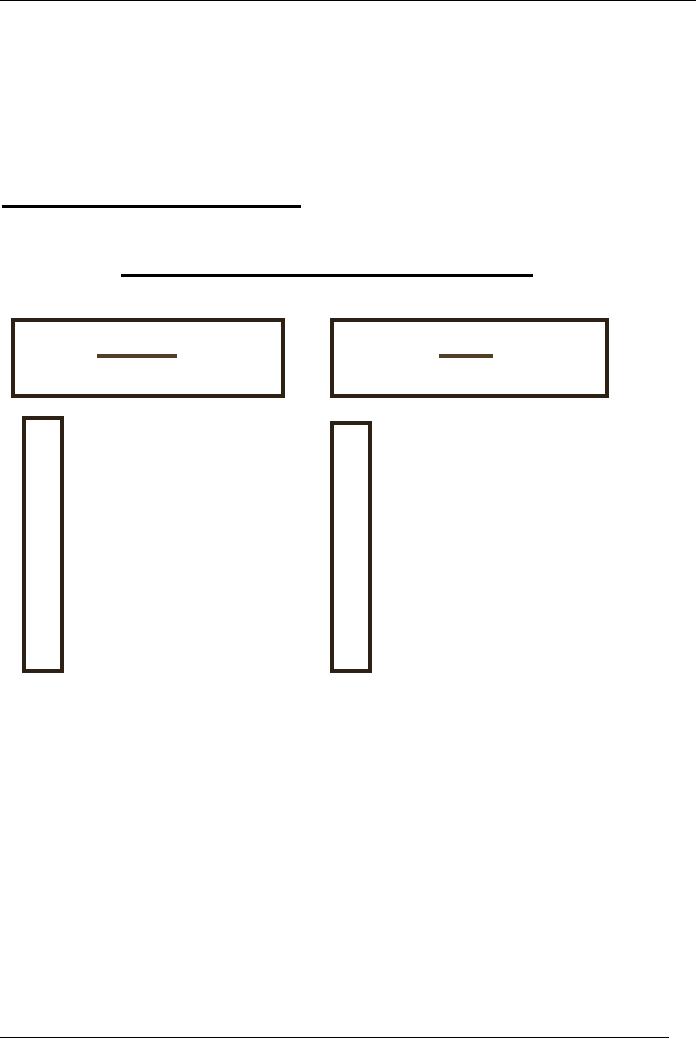 |

Advertising
and Promotion (MKT621)
VU
Lesson
16
PROBLEM
SOLVING STRATEGIES
OVERVIEW
Like
every situation advertising also
has its ups and downs. There
are often different
problems
and
this is precisely what will be
explained here in this lecture.
Problem solving strategies
will
be
explained and procedure to handle
them will be highlighted for
guidance in such
situations.
Besides
this persuasive advertising strategies
will also be penned.
PROBLEM
SOLVING STRATEGIES
PROBLEMS
SOLVING STRATEGIES
BASIC
OLD
RACE
- FORMULA
ROPE
- FORMULA
R
Research
R
Research
A
Action
O
Objectives
C
Communication
P
Programming
E
Evaluation
E
Evaluation
--
John
Marston
--
Jerry Hendrix
Procedure
to Handle Problems
Where
do you start?
�
Assemble readily available
facts.
�
Determine which audience is
affected or involved.
�
Decide if additional research is
needed to define problems &
evaluate its scope.
Where
do you go from
here?
Formulate
a hypothesis, assemble facts to test
the hypothesis & revise if
hypothesis is
disproved.
Elements
to consider in this planning:
a)
What is objective of this
effort?
b)
What do you want to
accomplish?
c)
What image of company you
want to project?
42

Advertising
and Promotion (MKT621)
VU
d)
What audiences are targets &
why?
Who
are other audiences whose
opinions matter?
�
What
message do you have for
each audience?
�
What
media can you use to carry
these messages?
�
What
response do you want from
each audience?
�
What
budget can you use for
this regular allocated
budget
----
or a special allocation?
�
What
is the best timing for
action?
�
Review
problems or obstacles that
might arise & make contingency
plans for these.
�
Devise
monitoring systems to know;
How
are you doing?
Evaluation
Once
It Is All Over-- how to know
what happened!
�
Plan for
evaluation.
�
Evaluate all aspects
:
1.
Impact:
�
Informational, attitudinal &
behavioral.
2.
Output:
�
Media efforts &
results.
�
Communicate results.
In
brief
�
Find the central core of
difficulty.
�
Check list of audiences
involved in the
problem.
�
Determine problem's status for
potential harm to the
organization.
�
List related difficulties to be
considered.
�
Explore the
alternatives.
�
Determine the desired
objectives.
Actually
you must see how
the solution fits into
long range plans which are
shaped to what you
see
as the Mission.
What
are the immediate plans
?
How
do these fit with long range
plans?
Short
term solutions that do not
fit with long range
objectives & are against
"Mission
Statement" are
wrong.
Don't
do them - Start over
Some
Barriers
�
Information you don't
know.
�
Effects of the way you
look at the problem.
�
Limitations faced by you.
(restrictions on choices the situation
offers)
�
Your limitations or
management's.
�
Problems associated with
upsetting the equilibrium of
organization.
43

Advertising
and Promotion (MKT621)
VU
Persuasive
Advertisement Strategy
Media
Orientation
�
What to tell Whom to
tell How to
tell
�
What Media to
communicate
�
Choice of medium is
critical
�
Must be believable e.g. Television
- This is highly credible
source/medium with
mass
penetration.
Message
Orientation
�
Actually message must be
evaluated.
�
To be effective persuasive appeals
must combine the rational
& the emotional.
�
To be persuasive, a message has to present
"Value
for money" to target
public.
�
Must be compatible with
motives of that audience.
Eight
principles apply to consumer
behavior
1.
Unpleasant appeals can be learned as
readily as pleasant ones.
2.
Appeals made over a period
of time are more
effective.
3.
Unique messages are better
remembered.
4.
It is easier to recognize an appeal
than to recall it.
5.
Knowledge of results increases
learning of a message.
6.
Repetition is more effective
when related to
satisfaction.
7.
Messages are easier to learn
when they do not interfere
with earlier habits.
8.
Learning a new pattern of
behavior can interfere with
remembering something
else.
44
Table of Contents:
- INTRODUCTION TO ADVERTISING:Its growing importance, Explanation of Personal and non-personal selling
- INTRODUCTION TO ADVERTISING:ADVANTAGES, Communication, Information, Various Media
- INTRODUCTION TO ADVERTISING:FUNCTIONS OF ADVERTISING, IMPACT OF ADVERTISING
- ADVERTISING AND SOCIETY:PRACTICAL BENEFITS, ETHICS IN ADVERTISING, Marketplace & Market space
- MARKETING TOOLS:COMPONENTS OF MARKETING MIX, PRODUCT LIFE CYCLE (PLC) CURVE
- MARKETING TOOLS:SWOT Analysis, Contents & Structure, ROLE & FUNCTION OF ADVERTISING
- ROLE AND FUNCTIONS OF ADVERTISING:Structure of an Advertising Agency, How to Select an Advertising Agency
- ADVERTISING PLANNING:ADVERTISING OBJECTIVES, Types of Advertising, Positioning Strategies
- POSITIONING:BRANDING, 7 Steps of Creative Process, UNIVERSAL ADVERTISING STANDARDS
- ADVERTISING MESSAGE:Message Content, BASIC TERMS & CONCEPTS
- ADVERTISING BUDGET:4 Methods to determine, ADVERTISING RESEARCH, ADVERTISING RESEARCH
- ADVERTISING REACH:BROAD COMMUNICATION OBJECTIVES, ADVERTISING COPY METHODS, MEDIA RESEARCH
- PRE – PLACEMENT EVALUATION:ACCOUNT PLANNING, MARKET, COMPETITION
- WORKING OF ADVERTISING:12 Steps to develop effective campaign, SOURCE or THE ADVERTISER
- ADVERTISING RESPONSE HIERARCHY MODELS:AIDA MODEL, PROCESS REQUIRED TO GET BIG IDEA
- PROBLEM SOLVING STRATEGIES:Procedure to Handle Problems, In brief, Eight principles apply to consumer behavior
- CONSUMER BEHAVIOUR:ADVERTISING APEALS, MEDIA MIX DECISIONS, Target Rating Point (TRP)
- CREATIVITY IN ADVERTISING:Three aspects are most accepted, Four Rules of Creativity
- COPY WRITER:CHARACTERISTICS OF COPYWRITER, IMPORTANCE OF LANGUAGE
- WHY ADVERTISING:Advertising & Market Education, ADVERTISEMENT CAMPAIGNS
- METHODS TO APPRECIATE A PROBLEM:SPONSORSHIP—an important tool, Special Characteristics
- IMPORTANT TOOL OF ADVERTISING:TELEVISION ADVERTISING, TRANSIT ADVERTISING
- ONLINE ADVERTISING:Banners, Logos, Email Ads, Keywords on Search Engines, New Developments
- ONLINE ADVERTISING:Structural Challenges, Adobe Photoshop, JAVA, HTML, DHTML, ASP & JSP
- SALES PROMOTION:Consumer Oriented Promotion, HOW TO USE TRADE PROMOTION, Dealing with the Trade
- PUBLICITY:PERSONAL SELLING, ROLE OF SALES PERSON, FUTURE OF GLOBAL ADVERTISING
- MARKETING ENVIRONMENT:Competitors, The Target Buyer, Segmenting your Market, FUTURE OF MARKET GROWTH
- MARKETING PLAN:Situational Analysis, Macro – Environment Situation, Marketing Objectives, Financial Objectives
- MARKETING PLAN:PROMOTING BUSINESS IN LOW COST, SUPPLY CHAIN, BUYER IDENTIFICATION
- HOW TO BE GOOD CLIENTS:CHANNEL BUYERS, HOW TO BE GOOD CLIENTS 14 RULES
- CLIENT – AGENCY RELATIONSHIP:HOW TO KEEP CLIENTS (10 Ways), Three Points for Consideration
- CLIENT – AGENCY RELATIONSHIP:ADVERTISING WITHOUT AN AGENCY, LOGO AND CORPORATE IDENTITY
- NEWSPAPER ADVERTISING:AD PRODUCTION,TYPES OF NEWSPAPER ADS, CIRCULATION
- OTHER ADVERTISING MEDIUM:HOW TO USE MAGAZINES, HOW TO USE RADIO, Daypart buying options
- UTILITY OF VARIOUS MEDIA:TAPE OR FILM, UTILITY OF TV, DIRECT MAIL PACKAGE
- OTHER ADVERTISING MEDIA:POINT OF PURCHASE (POP), TRANSIT ADVERTISING, LIMITS OF ADVERTISING
- CONTINUOUS TRACKING:PLANNING CAMPAIGN, HOW TO UNDERSTAND ADS, ASK BASIC QUESTIONS
- SEASONAL ADVERTISING:MAXIMIZING IMPACT, THE WEB ADVERTISING, MEASURING ADVERTISING
- COMPONENTS OF ADVERTISING:BUY - OLOGY OF MIND, BUY - OLOGY OF MIND
- CRITICISM ON ADVERTISING:SHOULD ADVERTISING BE ABOLISHED,
- EFFECT OF ADVERTISING:HOW TO PROMPT AWARENESS, CREATING DESIGN THAT SELLS
- CREATING EFFECTIVE DESIGN:LANGUAGE OF TYPOGRAPHY, HEADLINES THAT COMMUNICATE
- WORKSHEETS:DEMOGRAPHICS OF YOUR TARGET, YOUR COMPETITOR
- GLOSSARY OF ADVERTISING:ACCOUNT EXECUTIVE, PROOF, VOICE OVER
- CONCEPT OF AN AD:HOW TO DEVELOP A CONCEPT OF AN AD